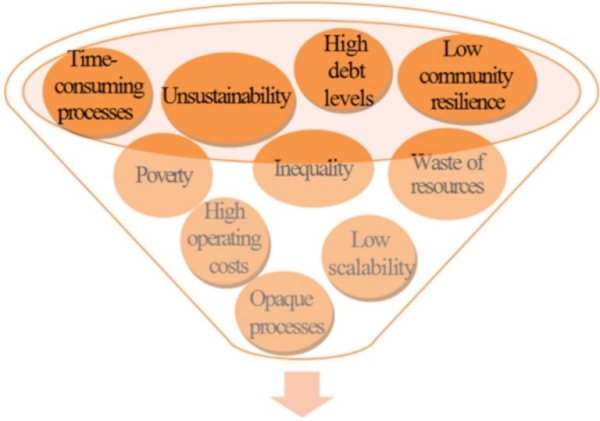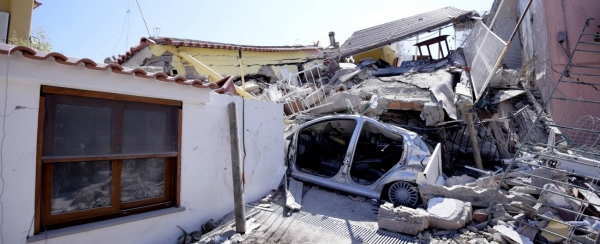Opportunities and limits of DGML homes
Short version: homes are not furniture.
DGML is, as I explained yesterday, the practice of “Designing Global, Manufactur Locally: communities of people team up on the internet to design together some product, or service, then each community manufactures the pieces it needs by itself, at home.
A 2018 paper titled The Emergence of Open Construction Systems: A Sustainable Paradigm in the Construction Sector? by C. Priavolou analyzes how DGML is used also to try to solve a major problem in many parts of the world, that is affordable, environmentally sustainable housing.
The paper starts noting how traditional approaches to housing often fail to solve that problem, for all the reasons shown in this picture:

Limits of raditional housing: debt, waste, poverty, unstainability...
</em></u>
and from the fact that “the dominant model in the construction sector manifests low productivity rates and unsustainability, judging from the high percentages of carbon dioxide emissions in the industry”.
The paper explains how the DGML model applied to design and construction of homes can solve those problems thanks to:
- the removal of planned obsolescence, that is houses that last only a few decades;
- on-demand production, using local materials;
- sharing practices and mutualisation of both digital and material resources.
Thanks to these features, the paper argues, “DGML could pave the way for sustainable practices in the built environment”, facilitating modular design based on reusable, easily repairable or recyclable elements.
Internet-based collaborative design would also make it easier for everybody involved, from architects to tenants, to contribute “in a creative, socialising and convivial way”: more individuals, collectives, and firms would be contributing to the improvement of open construction systems and the related policy making.
In this way, the development of flexible modular structures via a common dimensional framework could prompt the “completion of the universal building puzzle”.
Also, by taking advantage of the non-existence or ambiguity of regulations, loopholes in building codes allow communities to operate in a more restriction-free manner.
A few words on the limits of DGML housing
The paper concludes that, thanks to their flexibility, design and construction of homes the DGML way may “fill the gaps of market-based solutions for sustainable housing through the development of alternative systems of housing provision, while providing affordable housing to the people in need."
Now…
A DGML version of IKEA, that is global DGML furniture, is probably overdue. We already know that being able to buy exactly the same sofa, or bed, can make sense for many people living thousands of kilometers away. Homes are not furniture, however.
DGML homes have great potential. The more work happens in this area, the better. This said, let’s not forget some limits, or side effects, of “DGML homes for all” visions.
The first is that really affordable DGML homes would distracts from reuse, and increase soil consumption: let’s make new homes, that is occupy even more land, only after all the vacant homes in an area are put to better use.
Other limits that indeed are mentioned in the paper, are scalability and flexibility.
DIY single-family homes are one thing, DIY condominiums (even small ones) are another. The former are much, much easier to really get right than the latter. But most, if not all, present and future urban areas need density, that is condominiums, to be sustainable, not sprawling.
As for flexibility, environmental conditions and availability of materials are even more diverse than zoning and building codes. Construction and manufacturing techniques yes, they are very likely reusable with little or no changes from country to country. But modular home parts, that is roofs, walls, pipes, or their designs… would be reusable as such only inside the same country, if not in a specific region. It would still be a huge progress of course, but let’s “label” it properly.
Finally, a word about safety and the freedom for communities to operate in “a more restriction-free manner”. This freedom is exactly what we have had, for many decades now, here in Italy (but I assume it is the same in many other parts of the world), not by law, but by deliberate, persistent decisions by almost all parties to make laws, and then not apply them, in order to gain votes.
This is a freedom that we have had, and to a good extent still have, and this is what its results can be:

some houses built (seriously!) in a creative, socialising and convivial way
</em></u>
On August 21st 2017, an earthquake completely destroyed 640 houses in Ischia, an island that counts about twenty thousand residents, and (in 2017) over twenty-seven thousands pending requests for building amnesties, to regularize abusive and/or unsafe homes built in the last 5 / 6 decades.
So… DGML homes research and experiments? The more the better. DGML homes? Maybe the less the better, and none at all in some areas.
(This post was drafted in May 2020, but only put online in August, because… my coronavirus reports, of course)
Who writes this, why, and how to help
I am Marco Fioretti, tech writer and aspiring polymath doing human-digital research and popularization.
I do it because YOUR civil rights and the quality of YOUR life depend every year more on how software is used AROUND you.
To this end, I have already shared more than a million words on this blog, without any paywall or user tracking, and am sharing the next million through a newsletter, also without any paywall.
The more direct support I get, the more I can continue to inform for free parents, teachers, decision makers, and everybody else who should know more stuff like this. You can support me with paid subscriptions to my newsletter, donations via PayPal (mfioretti@nexaima.net) or LiberaPay, or in any of the other ways listed here.THANKS for your support!